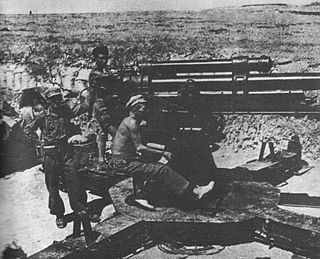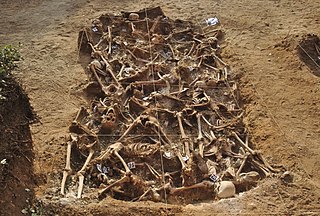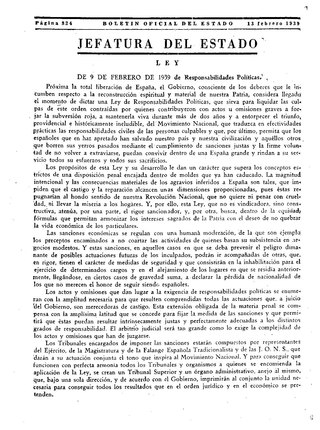
The Battle of the Ebro was the longest and largest battle of the Spanish Civil War and the greatest, in terms of manpower, logistics and material ever fought on Spanish soil. It took place between July and November 1938, with fighting mainly concentrated in two areas on the lower course of the Ebro River, the Terra Alta comarca of Catalonia, and the Auts area close to Fayón (Faió) in the lower Matarranya, Eastern Lower Aragon. These sparsely populated areas saw the largest array of armies in the war. The battle was disastrous for the Second Spanish Republic, with tens of thousands left dead or wounded and little effect on the advance of the Nationalists.

Juan Negrín López was a Spanish physician and politician who served as prime minister of the Second Spanish Republic. He was a leader of the Spanish Socialist Workers' Party and of the left-leaning Popular Front government during the Spanish Civil War. He also served as finance minister. He was the last Loyalist premier of Spain (1937–1939), leading the Republican forces defeated by the Nationalists under General Francisco Franco. He was President of the Council of Ministers of the Second Spanish Republic and the Spanish Republican government in exile between 1937 and 1945. He died in exile in Paris, France.

The War in the North was a theatre of the Spanish Civil War that occurred in northern Spain from 31 March to 21 October 1937.

The Catalonia Offensive was part of the Spanish Civil War. The Nationalist Army started the offensive on 23 December 1938 and rapidly conquered Republican-held Catalonia with Barcelona. Barcelona was captured on 26 January 1939. The Republican government headed for the French border. Thousands of people fleeing the Nationalists also crossed the frontier in the following month, to be placed in internment camps. Franco closed the border with France by 10 February 1939.

In the history of Spain, the White Terror describes the political repression, including executions and rapes, which were carried out by the Nationalist faction during the Spanish Civil War (1936–1939), as well as during the first nine years of the regime of General Francisco Franco. In the 1936–1945 period, Francoist Spain had many officially designated enemies: supporters of the Second Spanish Republic (1931–1939), liberals, socialists of different stripes, Protestants, intellectuals, homosexual people, Freemasons, Jews, and Basque, Catalan, Andalusian, and Galician nationalists.

Castrillo del Val is a municipality located in the province of Burgos, Castile and León, Spain. It is in the valley of the River Arlanzón.

The XYZ Line, also known as the Matallana Line, was a system of fortifications built in 1938 during the Spanish Civil War to defend Valencia, the capital of the Second Spanish Republic. The XYZ Line was a simple system of trenches and bunkers, built to withstand heavy artillery or 450-kilogram (992 lb) aerial bombs, and took advantage of some of the most difficult terrain in Spain in the Iberian System ranges to the north and northeast of Valencia. The XYZ Line was successful at halting the Nationalist advance on Valencia, being one of the last Republican victories of the war, and allowed the Republicans to start the Battle of the Ebro.

The Spanish Civil War was a military conflict fought from 1936 to 1939 between the Republicans and the Nationalists. Republicans were loyal to the left-leaning Popular Front government of the Second Spanish Republic, and consisted of various socialist, communist, separatist, anarchist, and republican parties, some of which had opposed the government in the pre-war period. The opposing Nationalists were an alliance of Falangists, monarchists, conservatives, and traditionalists led by a military junta among whom General Francisco Franco quickly achieved a preponderant role. Due to the international political climate at the time, the war had many facets and was variously viewed as class struggle, a religious struggle, a struggle between dictatorship and republican democracy, between revolution and counterrevolution, and between fascism and communism. According to Claude Bowers, U.S. ambassador to Spain during the war, it was the "dress rehearsal" for World War II. The Nationalists won the war, which ended in early 1939, and ruled Spain until Franco's death in November 1975.

The Paracuellos massacres were a series of mass killings of civilians and prisoners of war by the Republican faction of the Spanish Civil War that took place before and during the Siege of Madrid during the early stages of the war. The death toll remains a subject of debate and controversy.

The Law of Political Responsibilities was a law issued by Francoist Spain on 13 February 1939 two months before the end of the Spanish Civil War. The law targeted all supporters of the Second Spanish Republic and penalized membership in the Popular Front of the defeated republic.

The Nationalist faction or Rebel faction was a major faction in the Spanish Civil War of 1936 to 1939. It was composed of a variety of right-leaning political groups that supported the Spanish Coup of July 1936 against the Second Spanish Republic and Republican faction and sought to depose Manuel Azaña, including the Falange, the CEDA, and two rival monarchist claimants: the Alfonsist Renovación Española and the Carlist Traditionalist Communion. In 1937, all the groups were merged into the FET y de las JONS. After the death of the faction's early leaders, General Francisco Franco, one of the members of the 1936 coup, headed the Nationalists throughout most of the war, and emerged as the dictator of Spain until his death in 1975.

The Republican faction, also known as the Loyalist faction or the Government faction, was the side in the Spanish Civil War of 1936 to 1939 that supported the government of the Second Spanish Republic against the Nationalist faction of the military rebellion. The name Republicans was mainly used by its members and supporters, while its opponents used the term Rojos (Reds) to refer to this faction due to its left-leaning ideology, including far-left communist and anarchist groups, and the support it received from the Soviet Union. At the beginning of the war, the Republicans outnumbered the Nationalists by ten-to-one, but by January 1937 that advantage had dropped to four-to-one.

The Convoy de la Victoria was a Spanish naval battle on 5 August 1936 in the Strait of Gibraltar during the Spanish Civil War, between the escort of a Nationalist convoy and the Republican Navy destroyer Alcalá Galiano.

The final offensive of the Spanish Civil War took place between 26 March and 1 April 1939, towards the end of the Spanish Civil War. On 5 March 1939, the Republican Army, led by Colonel Segismundo Casado and the politician Julián Besteiro, rose against the socialist prime minister Juan Negrín, and formed a military junta, the National Defence Council to negotiate a peace deal. Negrín fled to France but the communist troops around Madrid rose against the junta, starting a civil war within the civil war. Casado defeated them and started peace negotiations with the Nationalists. Francisco Franco, however, was willing to accept only an unconditional surrender. On 26 March, the Nationalists started a general offensive and by 31 March, they controlled all of Spanish territory. Hundreds of thousands of Republicans were arrested and interned in concentration camps.
The lost children of Francoism were the children abducted from Republican parents, who were either in jail or had been assassinated by Nationalist troops, during the Spanish Civil War and Francoist Spain, and later from random citizens or girls confined in the notorious Women's Protection Board. The kidnapped children were sometimes also victims of child trafficking and forced adoption.

The Levante Offensive, launched near the end of March 1938, was an attempt by Nationalist forces under Francisco Franco to capture the Republican held city of Valencia during the Spanish Civil War. The Nationalists occupied the province of Castellón, but the offensive failed due to bad weather and the dogged resistance of the Republican troops at the XYZ defensive line.

Women prisoners in Francoist Spain were often there because of specific repression aimed at women. During the Civil War, many women were in prison because family members had Republican sympathies or the authorities wanted to lure out male Republican affiliated relatives; it was not a result of anything the women did themselves. The Law of Political Responsibilities, adopted on 13 February 1939, made such repression easier and was not formally removed from the Criminal Code until 1966. Prisoners and people in concentration camps, both male and female, would total over three quarters of a million by the end of the Spanish Civil War. Of these, 14,000 women were held in the Las Ventas Model prison in Madrid.
Motherhood in Francoist Spain was the definition of being a woman. Motherhood was important to the state because Hispanic eugenics saw women's bodies as state property. They were needed to rebuild Spain by creating a race of people aligned with the prevailing Catholic morality of the period. The regime then created numerous laws to enforce its vision of motherhood. These would not begin to relax until the late 1950s, and only face radical changes in the post-Franco period.

Gender roles in Francoist Spain became more regressive following the end of the Spanish Civil War. Women, who had achieved some degree of liberation during the Second Republic, were forced back into the home. Misogyny and heteronormativity became linchpins in the new fascist Spain, underpinned by Hispanic eugenics. Under this system, anyone who did not adhere to state and religious mandated gender roles and who expressed any deviance from Roman Catholic sexual norms was considered by both church and state to be a sex pervert.
Hispanic eugenics are a positive eugenics based around the political purification of a people, developed in Spain during the interwar period and put into practice in the Spanish Civil War, eventually being made into political policy in Francoist Spain. The concept was first expounded upon in the 1930s by men like Antonio Vallejo-Nájera and Gregorio Marañón. It was heavily influenced by Roman Catholicism. Much of this was realized through Francoist policies around the role of women and their bodies.
















